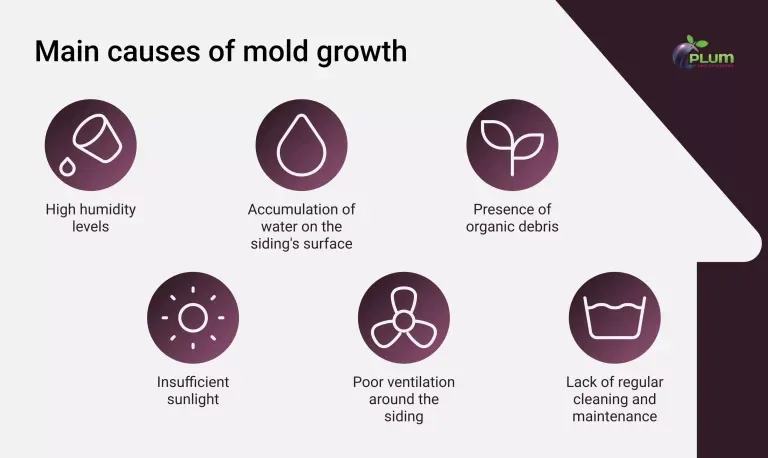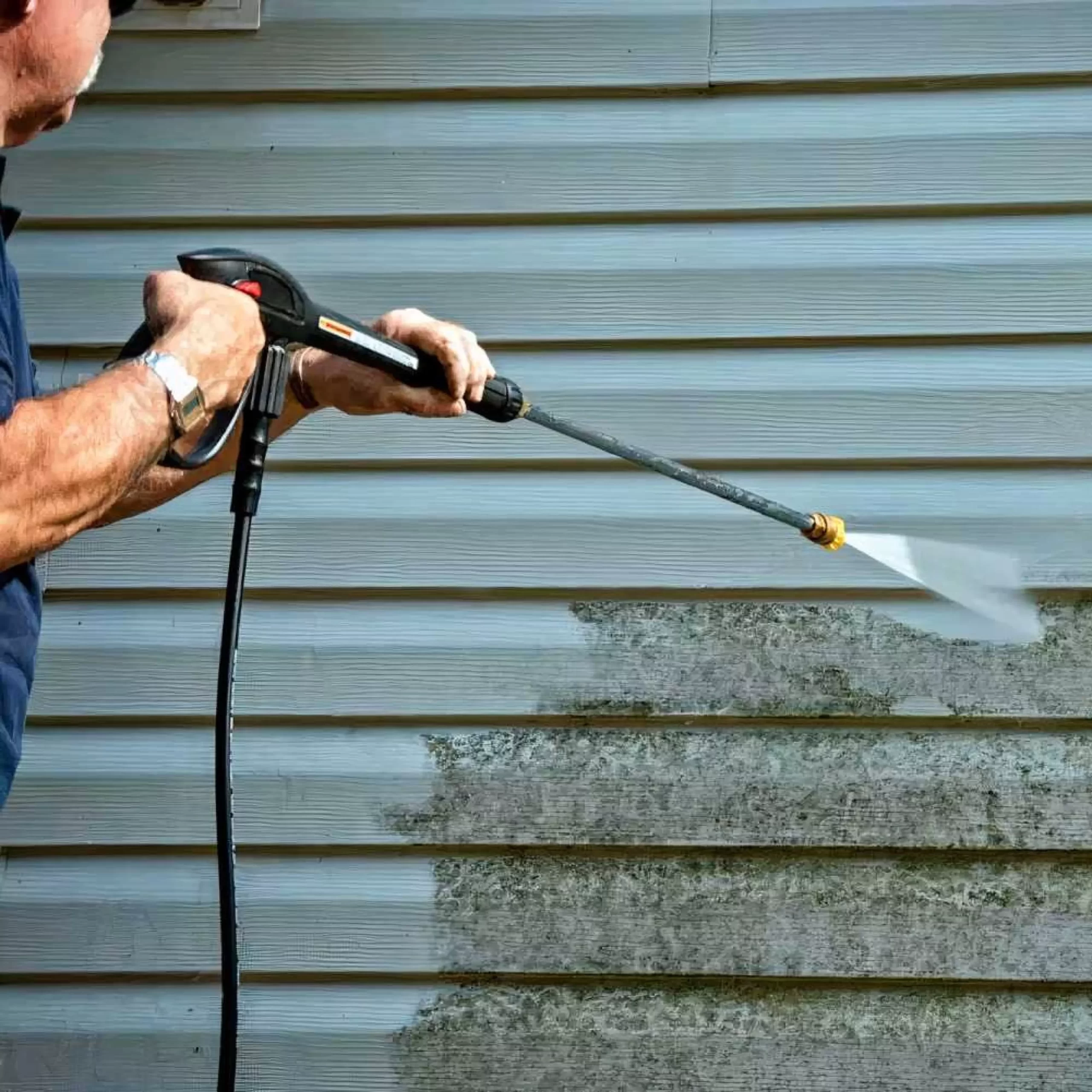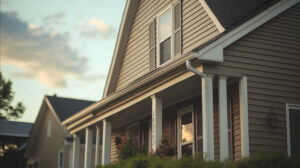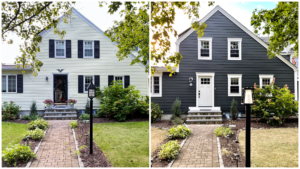While vinyl siding initially needs low maintenance, a not-so-friendly visitor can show up over time: mold. Those once-vibrant panels can become speckled with unsightly green patches, leaving your home looking less than attractive.
The good news? Mold on house siding is easier to tackle than when it is indoors. Options for cleaning mold off vinyl siding include DIY (do-it-yourself) methods such as carefully executed pressure washing or using homemade solutions like vinegar and bleach. Alternatively, opting for professional services from experienced providers like Plum ProExteriors ensures a thorough cleaning process that safeguards the integrity of the siding.
In this brief, you will learn how to clean mildew off vinyl siding the best way and how to care for your siding to prevent mildew from coming back. Let’s begin our research!
What causes mildew to grow on vinyl sidings: main reasons
Vinyl siding has become a widely favored option for exterior cladding due to its blend of cost-effectiveness, durability, and low maintenance needs.
This siding type resembles traditional wood siding but boasts additional advantages, such as resistance to rot, warping, and insect damage. Its lightweight composition makes installation straightforward and helps reduce labor costs associated with siding projects.
Vinyl siding panels are designed with interlocking features that provide a seamless look while allowing for natural expansion and contraction with temperature changes. Its ease of maintenance and durability make it an excellent choice for improving the aesthetic appeal and protection of residential exteriors.
In general, vinyl siding possesses characteristics that can make it susceptible to mold growth. However, external factors can contribute to mildew appearance on your home’s siding.

- High humidity levels: Areas with frequent humidity or moisture can create a conducive environment for mildew to appear on vinyl siding.
- Accumulation of water on the siding’s surface: Water pooling or not draining properly on the vinyl siding can promote mildew growth, especially in shaded or damp areas.
- Presence of organic debris: Organic matter such as dirt, pollen, and dead insects can accumulate on vinyl siding, providing nutrients for mildew to grow.
- Insufficient sunlight: Vinyl siding that does not receive adequate sunlight may remain damp longer after rain or dew, increasing the likelihood of mildew growth.
- Poor ventilation around the siding: Inadequate airflow around the siding can trap moisture, creating an environment where mildew can develop.
- Lack of regular cleaning and maintenance: Neglecting to clean vinyl siding regularly allows dirt and organic matter to build up, creating conditions favorable for mildew growth.
Understanding these factors can help homeowners take proactive steps to prevent mildew from forming on their vinyl siding, such as improving drainage, enhancing ventilation, and maintaining a clean exterior surface. Regular inspection and timely cleaning are vital for keeping a look and ensuring the longevity of your vinyl siding.
Want the clean vinyl siding? Our specialists at Plum ProExteriors will help. Contact us.
How to remove mold from vinyl siding?
Cleaning mold from vinyl siding requires a methodical approach to ensure thorough removal without damaging the material. Here are some effective and proven methods you can use:
Pressure washing
One popular way to tackle with vinyl siding mold problems is applying pressure washing. However, it’s best to hire a professional for this task because improper techniques can cause damage.
High pressure can blast holes through the vinyl, creating dents and warping. It may also leave streaks or water marks if not handled correctly. If you choose to do it yourself, use the widest nozzle setting and point it straight at the siding to avoid forcing water underneath, which can lead to bigger issues.
Homemade vinyl siding cleaner
You can create homemade siding cleaner solutions for light mold and mildew stains. Here is one example: Combine 30% white vinegar and 70% water in a spray bottle. Spray the obtained solution onto the siding areas affected by mold.
For more stubborn stains, prepare a potent homemade cleaner by mixing 1 gallon of water with 1/3 cup of powdered laundry detergent, 1 quart of liquid laundry bleach, and 2/3 cup of powdered household cleaner. Apply this mixture using a sponge or soft brush, gently scrubbing the surface to remove the stains effectively.
It’s important to steer clear of certain materials when cleaning vinyl siding, as they can cause irreversible damage to the surface. Many common household cleaners contain chemicals that react unfavorably with the plastic, leading to cosmetic harm and significantly reducing the siding’s lifespan. Avoid using:
- Organic solvents,
- Liquid degreaser,
- Acetone-based nail polish remover,
- Full-strength chlorine bleach,
- Furniture polish.
These cleaners are often too harsh to remove mold from siding of house. Opting for gentler cleaning agents and employing mild agitation is safer and more effective in maintaining the integrity of your vinyl siding.
Professional cleaning services
Hiring a skilled and reliable cleaning service provider is another option for effectively cleaning mold off vinyl siding. An experienced siding service contractor, like Plum ProExteriors, has the expertise and equipment to clean vinyl siding mildew safely and efficiently, minimizing the risk of damage. They can use specialized cleaners and techniques tailored to your siding’s needs, ensuring thorough mold removal and maintaining the siding’s integrity.
By choosing the right cleaning method and taking preventive measures, you can keep your vinyl siding mold-free and enhance its longevity and appearance.

Protecting your siding from future mildew growth
While selecting mold-resistant siding is ideal, there are several strategies to prevent mildew from appearing on vinyl siding.
Ensure your siding is dry
The most effective measure is to keep the siding dry to discourage mold growth. Identify and address sources of moisture.
- Gutter leaks: Damaged or clogged gutters can lead to moisture accumulation on siding, particularly during rainfall. Promptly fix gutter leaks to prevent constant wetness.
- Dryer ventilation: Improper dryer ventilation can cause moisture buildup on siding where the dryer exhausts steam. To mitigate this issue, position dryers in well-ventilated areas.
- Vegetation: Dense vegetation like vines, moss, and overhanging trees can obstruct sunlight and airflow, promoting mildew growth. Trim vegetation regularly to allow sunlight to reach and heat the siding.
Regularly clean siding
Remove dirt, mold, and grime periodically to prevent mold buildup. You can use special products such as anti mold spray for vinyl siding and others. Use appropriate tools to avoid damaging the siding (use a lengthy-handled brush, avoid rigid bristles, and steel wool), or consider professional cleaning and washing services.
Conduct regular inspections
These inspections are vital to maintaining the condition of your vinyl siding. During these inspections, carefully examine the siding for signs of mold growth, accumulated dirt, and any structural damage, such as holes or cracks, that may have been caused by pests or other factors. Promptly addressing these issues can prevent them from escalating and ensure that your siding remains in optimal condition for years.
By applying these preventive measures, you can effectively inhibit vinyl siding mold problems and preserve its condition.
Need top vinyl siding services? Let our enthusiastic team help you. Contact us.
Conclusion
In general, maintaining vinyl siding requires proactive care to prevent the growth of mold and mildew, which can diminish the aesthetic appeal of your home over time. While vinyl siding is initially easy to maintain, it can become susceptible to mold if neglected. Understanding the factors contributing to mildew, such as high humidity, water accumulation, and inadequate sunlight exposure, empowers homeowners to take preventive measures.
If you need a reliable siding service contractor to help clean, wash, or paint your siding, contact us. At Plum ProExteriors, we deliver top-notch siding services that meet your home’s requirements. We will effectively maintain and clean your vinyl siding, ensuring it stays in pristine condition for years to come.







